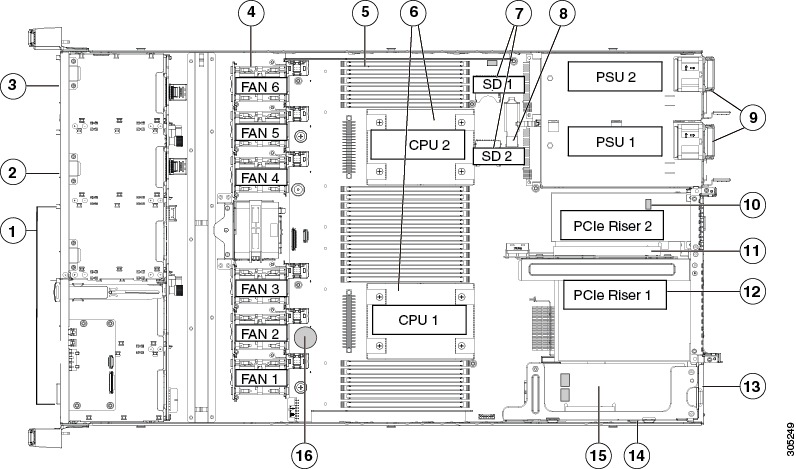Overview
This chapter provides an overview of the Cisco HX220c M4 HyperFlex Node features:
Cisco HyperFlex Systems Related Documentation
Links for related Cisco HyperFlex Systems documentation such as the Getting Started Guide, Administration Guide, and Release Notes are listed in the Documentation Roadmap.
External Features Overview
The figures in this chapter show an overview of external node features.
- The front-panel features are shown in Figure 1-1.
- The rear panel features are shown in Figure 1-2.
Figure 1-1 Front Panel Features

|
|
See Replacing Drives for information about supported drives. |
|
|
|
|
|
||
|
|
Drive bay 2: SSD caching drive The supported SSD differs between the HX220c and HX220c All-Flash nodes. See Replacing Drives. |
|
|
|
|
|
||
|
|
|
||
|
|
|
KVM connector (used with KVM cable that provides two USB 2.0, one VGA, and one serial connector) |
|
|
|
|
Figure 1-2 Rear Panel Features

|
|
|
||
|
|
|
||
|
|
Modular LAN-on-motherboard (mLOM) card slot for Cisco VIC 1227 |
|
|
|
|
|
||
|
|
|
||
|
|
|
Replaceable Component Locations
This section shows the locations of the field-replaceable components. The view in Figure 1-3 is from the top down with the top cover and air baffle removed.
Figure 1-3 Replaceable Component Locations

|
|
See Replacing Drives for information about supported drives. |
|
Power supplies (up to two, hot-swappable when redundant as 1+1) |
|
|
Drive bay 2: SSD caching drive The supported caching SSD differs between the HX220c and HX220c All-Flash nodes. See Replacing Drives. |
|
Trusted platform module (TPM) socket on motherboard (not visible in this view) |
|
|
|
||
|
|
|
||
|
|
|
Modular LOM (mLOM) connector on chassis floor for Cisco VIC 1227 |
|
|
|
|
Cisco modular HBA PCIe riser (dedicated riser with horizontal socket) |
|
|
|
|
||
|
|
|
Summary of Node Features
|
|
|
|---|---|
24 DDR4 DIMM1 sockets on the motherboard (12 each CPU). |
|
BMC, running Cisco Integrated Management Controller (Cisco IMC) firmware. Depending on your Cisco IMC settings, Cisco IMC can be accessed through the |
|
|
|
Dedicated socket that can be used to add an mLOM card for additional rear-panel connectivity. |
|
1-Gb BASE-T Ethernet LAN ports support the wake-on-LAN (WoL) standard. |
|
Two AC power supplies: 770 W AC each. Redundant as 1+1. See Power Specifications. |
|
The advanced configuration and power interface (ACPI) 4.0 standard is supported. |
|
Two horizontal PCIe4 expansion slots (single riser assembly). |
|
The bus slots in this node support the InfiniBand architecture. |
|
Drives are installed into front-panel drive bays:
– – See Cisco HX220c All-Flash HyperFlex Nodes Overview for more information. |
|
One internal USB 3.0 port on the motherboard that you can use with a USB thumb drive for additional storage. |
|
The node has a dedicated internal riser for a PCIe-style Cisco modular HBA card. For a list of controller options and required cabling, see Supported HBAs and Required Cables. |
|
VGA video resolution up to 1920 x 1200, 16 bpp at 60 Hz, and up to 256 MB of video memory. |
|
|
Cisco HX220c All-Flash HyperFlex Nodes Overview
The HX220c All-Flash HyperFlex node contains all SSDs, rather than the hybrid mix of SSDs and HDDs that is used in the HX220c HyperFlex node. Enterprise value SSDs are used for the persistent data drives. Enterprise high-endurance SSDs are used for the caching drives.
Note the following considerations and restrictions:
- The minimum Cisco HyperFlex software required is Release 2.0 or later.
- HX220c All-Flash HyperFlex nodes are ordered as specific All-Flash PIDs; All-Flash configurations are supported only on those PIDs.
- Conversion from hybrid HX220c configuration to HX220c All-Flash configuration is not supported.
- Mixing hybrid HX220c HyperFlex nodes with HX220c All-Flash HyperFlex nodes within the same HyperFlex cluster is not supported.
See HX220c Drive Configuration Comparison for specifics about drive PIDs supported in the node types.
 Feedback
Feedback